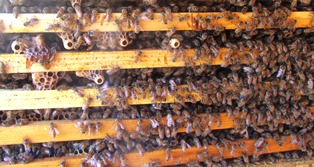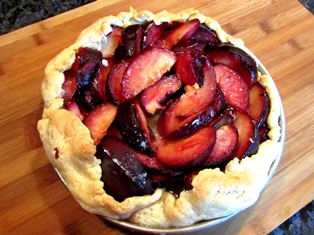Cold Weather Means Protecting Citrus, Covering Hives
It’s hard to believe Thanksgiving is next week and already, the first snows have arrived in the Sierras and Rockies.
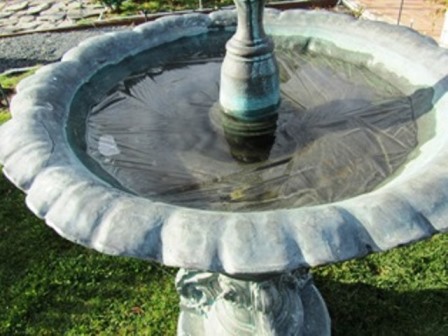
The water in our Italian fountain froze overnight and now the birds and bees that drink there must wait for the sun to melt the ice.
The plunge of nighttime temperatures here on the Henny Penny Farmette are hovering at frost and freezing levels. This morning, I walked with a steaming cup of coffee and noticed the thermometer hovering at 39 degrees Fahrenheit. That means our citrus trees and other frost-intolerant plants must be protected or moved indoors.
The work I’ve been bearing down on–a new book, mystery promo, and prep for Thanksgiving–now have to be put aside for a few hours. I’ve got plenty of cold-weather work to do outside.
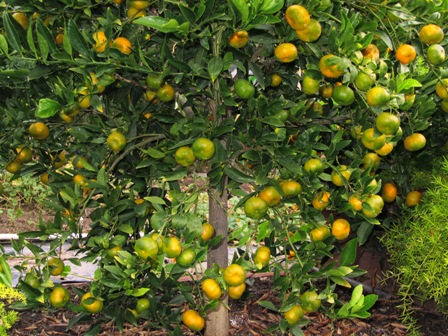
Our Satsuma mandarin orange tree prolifically bears fruit this time of year but is susceptible to freeze
Citrus trees will be covered with blankets against the frost. I’m hanging the heat lamp in my chicken house. I need to clean the chicken house, put more straw in the nesting boxes, and a ground corncob material on the floor. Already, I’ve put the windows back in (leaving a crack open for ventilation).
I opened the beehives last weekend and added an extension onto one hive–something not normally done during autumn when you typically shrink the size of your hives. The hive seemed overpopulated and the bees seemed stressed. After closing that hive, I wrapped both of them with blankets.
With the the citrus protected, the heat lamp in the chicken house, and the beehives covered, I can return to my indoor work . . . it never stops but my passion has always been to live close to the earth and write. This is the good life, made better by this wonderful Mediterranean-like climate that enable our citrus and grapes to thrive (although plunging temps make for a little extra work protecting them).
* * *
Enjoy reading about farming topics? Check out my cozy mysteries–A BEELINE TO MURDER and also THE MURDER OF A QUEEN BEE (both in the Henny Penny Farmette series from Kensington Publishing).
These novels are chocked full of recipes, farming tips, chicken and beekeeping tips, sayings and, of course, a charming cozy mystery. For more info, click on the links under the pictures.
The books are available through online retailers such as Amazon, Barnes & Noble, Kobo Books, and Walmart as well as from traditional bookstores everywhere.
See, http://tinyurl.com/hxy3s8q
This debut novel launched the Henny Penny Farmette series of mysteries and sold out its first press run. It’s now available in mass market paperback and other formats.
See, http://tinyurl.com/h4kou4g
NEWLY RELEASED! This, the second cozy mystery in the Henny Penny Farmette series, is garnering great reviews from readers and industry publications.
Summer Salad with a Mediterranean Flair
Inspired by a salad made of lentilles du Puy that I recently ate at a Mediterranean restaurant, I decided to create my own version of it.
The salad combines tiny greenish/brown French lentils with seasonal fresh produce such as heirloom tomatoes and zucchini . I added a chopped onion (sauteed) and some hard-boiled eggs. Dried mint, crumbled fine, along with a little salt and pepper is the only seasoning you’ll need.
This salad is delicious served warm. But it is equally tasty served chilled on very hot days.
French Lentil, Zucchini, and Tomato Salad
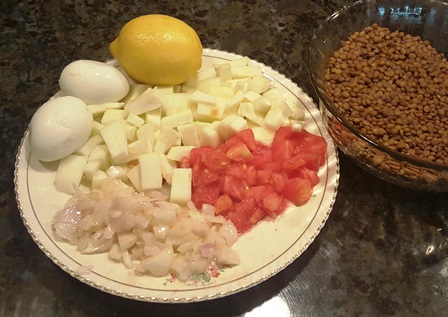
Ingredients for lentil salad include sauteed onions, heirloom tomato, zucchini, hard-boiled eggs, and fresh lemon juice
INGREDIENTS:
1 cup cooked French lentils (the small green or brown variety)
1/2 cup cooked Basmati rice
1 small firm tomato, skinned and chopped
1 cup peeled and chopped fresh zucchini
1 medium red or yellow onion, coarsely chopped and lightly sauteed
2 hard-boiled egg, chopped
1/4 c dried mint, crumbled fine by rubbing between your palms
1/2 medium juicy lemon
salt to taste
DIRECTIONS:
Combine the cooked lentils and rice. Add the zucchini, tomato, sauteed onion, and chopped hard-boiled egg to the lentil-rice mixture. Crumble the dried mint over the salad. Season with salt and pepper. Squeeze the juice from 1/2 lemon over the mixture and combine well before serving. Serves 4-6.
*Try pairing this salad with a rosemary chicken or lamb wrap for a light lunch.
* * *
If you enjoy reading about farmette topics (including gardening, beekeeping, and delicious recipes), check out my cozy mysteries A BEELINE TO MURDER and also THE MURDER OF A QUEEN BEE in the Henny Penny Farmette series (from Kensington Publishing).
These novels are available through online retailers such as Amazon, Barnes & Noble, Kobo Books, and Walmart as well as from traditional bookstores everywhere.
Now available in mass market paperback, this debut novel launched the Henny Penny Farmette series of mysteries and sold out its first press run.
The second cozy mystery in the Henny Penny Farmette series, available Sept. 29, 2016
Warm Pomegranate Sauce Dressing Dazzles on Spinach Salad

Pomegranate seeds add sweetness and crunch to salads but can eaten fresh, or you can extract the juice to make a lovely sauce.
Use fresh pomegranate juice if you would like a delicious sauce to use in salad dressing or other culinary creations. Pomegranate sauce made into a warm salad dressing dresses up a plain spinach salad like nothing else.
The warm pomegranate dressing is made by combining to blend 1/2 cup pomegranate sauce (recipe below), 1 Tablespoon of honey, 1 1/2 teaspoons minced fresh ginger, 1 cup California extra-virgin olive oil, and 1/2 cup coarsely chopped walnuts. Warm the dressing and pour over over a pound of freshly washed spinach leaves, 1/2 cup red onion, and 1 orange (peeled, seeded and with segments quartered).
Here’s how to make and preserve the pomegranate sauce.
INGREDIENTS:
5 cups of pomegranate juice (reamed from about 10 large fruits)
1/2 cup lemon juice
1 cup sugar
DIRECTIONS:
Wash thoroughly ten large pomegranates.
Cut in half and use a reamer to extract the juice from the seeds, discarding the membrane.
Strain the juice through cheesecloth several times to obtain 5 cups.
Combine the juice, lemon, and sugar in a large saucepan over medium-high heat.
Bring to a boil and then turn down the heat and simmer at 180 degrees Fahrenheit.
Reduce the sauce by half.
PROCESS:
Have ready 4 half-pint jam jars that have been washed on a hot cycle in the dishwasher and dried.
Fill the canner with water, place on heat, and bring to a simmer.
Simmer jar lids and rings.
Fill the jars with the pomegranate sauce, leaving 1/4 inch head space.
Affix hot lids to the jars and screw on the rings.
Lower the jars on the rack into the canner (water must cover the jars by at least an inch) and boil the water for 10 minutes.
Remove the jars of sauce and allow to cool.
Check seals, label, and then store until needed.
For more delicious recipes, farming tips, and beekeeping strategies as well as a cozy mystery, check out the first book in the Henny Penny Farmette series from Kensington Books in New York. Available on Amazon.com, Barnesandnoble.com, and in other online and traditional bookstores everywhere.

Ginger Tea for Colds and Flu
I’ve caught it . . . that nasty little bug affecting the throat and gut. Despite my best hygienic efforts at not catching the malady that many of my friends have recently endured, I have come down with it.
It started as a scratchy sore throat. Then a queasy stomach. Hoarseness and discomfort when swallowing followed. And the queasiness intensified to the point where even the sight of food sickened me. Oh, joy! Just what I didn’t want for the upcoming Thanksgiving week!
It’s always a good idea when you’re coming down with a cold or flu to increase your intake of fluids–herbal teas, juice, water, and popsicles. My former Chinese Tai Chi teacher advocated ginger tea to treat this type of malady; it’s my favorite home treatment for colds and flu.
Honey soothes the inflamed throat passages. Ginger settles the stomach. In fact, ginger has been used medicinally for 2,000 years in China to treat stomach upset, nausea, flatulence, and diarrhea.
GINGER TEA WITH HONEY
Ingredients:
1.5 inches of peeled and sliced fresh ginger root (about 1/2 cup)
5 to 6 cups of water
optional: 1/2 lemon, washed and sliced
optional: 2 sticks of cinnamon
honey or brown sugar, to taste
Directions:
Pour the water into a sauce pan.
Drop in the slices of ginger. Optional: add slices of lemon and cinnamon.
Simmer for 10 minutes.
Pour tea into a cup.
Stir in honey or brown sugar to sweeten.
Enjoy.
Fixing Jam that Won’t Jell
It happens in jam-making. You do everything right and the jam has a lovely color, flavor, and texture but remains runny long after the jars have cooled following the boiling water process. What to do?
Reprocess the jam in small batches (a quart at a time). A quart of jam fills four (8-ounce jars) or eight (4-ounce jars). Jam needs sugar, pectin, and lemon (acid) to properly jell. A batch I recently made turned out runny and I figured the fruit probably didn’t have enough pectin.
Overripe fruit has lower amounts of naturally occurring pectin whereas unripened fruit has higher amounts of pectin. Go figure!
If the fruit is super ripe (like the lug of apricots I used), the jam will need more pectin to properly jell. It should be reprocessed within 24 to 48 hours. Beyond that time frame, consider other options like using the runny jam as ice cream topping.
The initial step in the reprocessing is to remove the rubber-seal lids and pour all the jam into a pot. Rewash the jars (they will need to be hot when you put jam back into them. You’ll want use new lids, but you can reuse the rings. Heat the rings and new lids with rubber seals in a pot of simmering water.
When the jars are ready to come out of the dishwasher) and the lids are simmering under water in a shallow pan, then prepare the sugar/lemon juice/pectin mixture. Also, place a metal spoon into a glass with water and ice cubes to test the jam after repairing it.
For each quart-size batch of jam, you will need 1/4 cup of sugar, 2 Tablespoons of lemon juice, 4 teaspoons of powdered pectin and about 1/4 cup of water to dissolve everything. Stir well.
Add the sugar/acid/pectin mixture to the runny jam and cook until it reaches a roiling boil, stirring with a long wooden spoon. Boil for one minute. Remove the jam from the heat.
Test the jam for right consistency by placing some onto the stainless steel cold spoon. If it clumps and hangs, not running off, it will jell correctly.
Pour the jam into the hot jars. Wipe the mouths, if necessary to ensure a good seal. Cap each jar with a lid and ring. Process the jars submerged in a boiling water bath for 15 minutes, or according to your recipe.
I’d love to hear from you. Leave a comment letting me know if you’ve tried this process and how it worked for you. Don’t forget to tell me what kind of jam you repaired.
Plunging Temperatures–The Perfect Time to Bring Out the Honey
Cold and flu season is upon us. Here in Northern California, temps are plunging into the 20s and 30s and snow may be on its way. It is important to have a strong immune system to fight off these winter maladies.
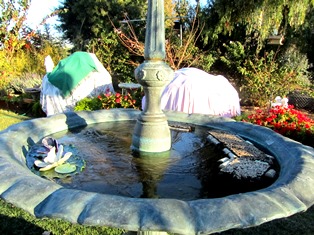
A frozen sheet of ice blocks the cork (permitting honeybees to drink) from moving in our backyard fountain
I’m taking down another jar of honey from the shelf where I stacked the jars over the summer. One teaspoon of raw buckwheat honey taken daily has been recommended by doctors as a powerful booster for the immune system. See http://www.prweb.com/releases/honey/buckwheat-honey-raw/prweb10242276.htm.
With the weather change comes the cold and flu season, so I shouldn’t have been surprised that my husband came home from work yesterday feeling out of sorts. Our neighbors have all been sick with colds and he’s concerned that he might have caught the bug.
I made him a cup of hot ginger tea, sweetened with raw honey. Honey can be consumed directly from the spoon or in hot water or in a tea or infusion with lemon.
I became a believer in honey and ginger tea years ago while studying Tai Chi. My 84-year-old teacher swore by drinking hot tea made by steeping an inch or two of fresh, peeled ginger and adding lemon and honey. Her stamina was nothing short of remarkable–she not only did Tai Chi, but sang opera, painted Chinese brush paintings, and taught many classes on herbs, reflexology, and other aspects of health and fitness in California and Hawaii.

Using sheets and blankets, we’ve covered the citrus trees around our farmette as temps are expected to plunge into the 20s tonight
Holistic practitioners have long espoused belief in the healthful benefits of raw honey. Honey was used by the ancient Greeks and Romans for a variety of maladies. Modern medical doctors and researchers have extolled honey’s antiseptic, antibacterial, and anti-inflammatory properties, and many cold and flu preparations contain honey as an ingredient. It a cost-effective way to treat a cough. See http://www.mayoclinic.com/health/honey/AN01799
Honey is the only food on the planet that does not go bad. It may crystallize, but it never becomes sugar. Crystallized honey in a jar can be returned to liquid by removing the lid and setting the jar in warm water. Never heat honey in the microwave or boil it because it will destroy the natural enzymes. And never give honey to a child under the age of one year because of the risk of their developing botulism.
You don’t have to wait to start gaining the benefit of raw honey. You can strengthen your immune system now before the dreaded cold and flu sweeps through your neighborhood. Daily consumption of a teaspoon of raw honey (from flower-fed bees) that has been minimally filtered can be good for your health and, especially, your immune system.
Rustic Pluot or Plum Tart with Italian Crostata Crust

Pluots or plums are first drizzled in lemon juice and dusted with flour, then placed into the tart with bits of butter
The farmer’s market has the dark purple-black plums and pluots in abundance now, so I thought I’d buy a few and whip up a rustic summer tart, Italian style.
I like the rustic tarts with the Italian style crostata crust because they are easy to make and the tart tastes so buttery and flaky. This recipe uses butter and also cream cheese that gives the tart a special lightness. For the filling, I used pluots for this one, but you could also use ripe plums.
To make the dough, I find it easier to just put the ingredients into the food processor with a steel blade and pulse a few times, adding ice water as needed.
Ingredients:
8 ounces cream cheese
2 sticks butter (1 cup)
2 cups flour
½ teaspoon salt
1 teaspoon cold water
6-7 large sweet pluots or dark plums
Juice from ½ medium lemon
2 Tablespoons butter
2 Tablespoons flour
Directions:
Preheat oven to 375 degrees Fahrenheit.
In a food processor with blade, process cream cheese, butter, flour, salt, and water into a ball.
*Roll out on a lightly floured surface in a circle to about ¼ inch thickness and 2-4 inches larger than your tart pan.
Place dough in a tart pan and pre-bake 10 minutes.
Wash, cut, stone, and cut pluots/plums into quarters.
Combine with lemon juice.
Toss with flour. If plums are juicy, you’ll need a bit more flour to absorb all that juice.
Cut butter into pieces and scatter around the plums as you layer the slices in the pan on top of the crostata dough.
Fold extra dough loosely back over the plums; it should not reach the center because you want a rustic look to the baked tart.
Bake for 30-45 minutes until pluots/plums are soft and dough is golden brown.
Serve warm with a dollop of whipping cream or a good vanilla ice cream.
*Avoid over-handling the dough as it will become tough.
 Facebook
Facebook Goodreads
Goodreads LinkedIn
LinkedIn Meera Lester
Meera Lester Twitter
Twitter







